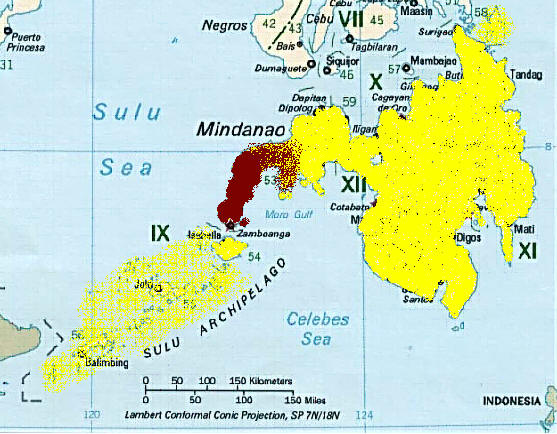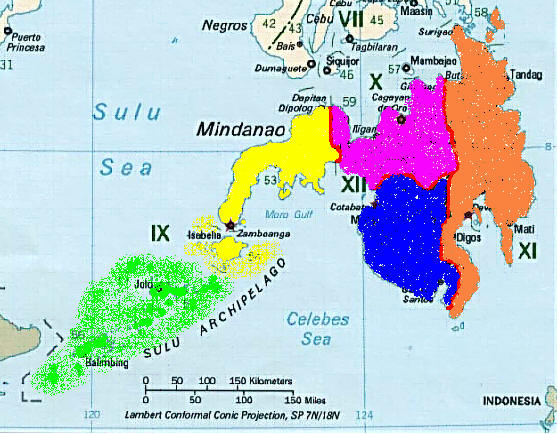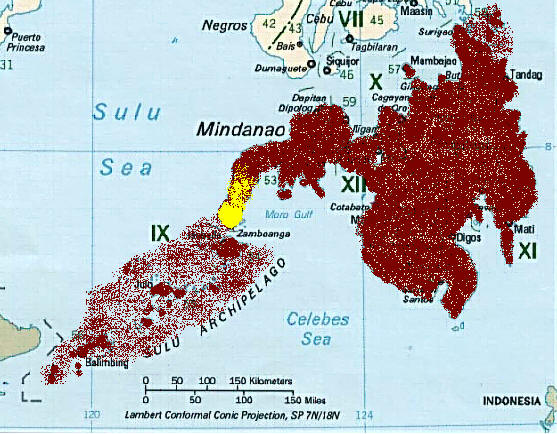|
1600s - 1800s |
|
|
Spanish Mindanao Territory as claimed by Spain: 1600s - 1800s, with Zamboanga & Fort del Pilar as center of government and the military. |
 |
|
|
|
|
1899 - 1903 |
|
|
Republic of Zamboanga, independent revolutionary state: May 1899 - March 1903
|
 |
|
|
|
|
1903 - 1913 |
|
|
Moro Province of The Philippines with Zamboanga as its Capital and seat of government
Moro Province - Old Zamboanga is made Capital of consolidated Mindanao, Basilan, & Sulu Archipelago, after abolishment.
The Moro Province was divided into five districts:
1. Zamboanga District (deep green color on map) *Province Capital: ancient Zamboanga town (yellow color on map)
2. Sulu District (light green color on map)
3. Lanao District (fuchsia color on map)
4. Cotabato District (blue color on map)
5. Davao District (orange color on map)
On September 15,1911, the governing body of the Provincia Mora, the legislative council passed Act. No.272 converting the Municipality of Zamboanga into a city. The ceremony was held on January 1, 1912 with the appointment of American Christopher F. Bader as the first City Mayor.
Then after, the Moro Province was established in Mindanao and Sulu, and the original ancient Zamboanga was made its capital. The first U.S. form of military government was the Moro Province and during the 12 years of its existence, the American Military Government converted the original Zamboanga into a city in the Commission Form, the first U.S.-created province in Mindanao to become/revert to a city. Zamboanga was already a major city of government and military importance under the Spanish Administration. The Commonwealth of the Philippines in 1937 declared Zamboanga as a Charter City. Progress and development in Zamboanga continued and in 1983, the Minister Interior Jose Roño proclaimed Zamboanga City as a highly urbanized city. [5] |

|
|
|
|
|
1913 - 1920 |
|
|
Department of Mindanao & Sulu of The Philippines with Zamboanga still as its Capital and seat of government
However, the U.S. military government of the Moro Province was abolished to give way to a new form of U.S. military/quasi local civilian government, called the Department of Mindanao and Sulu. This form of government entrusted to the Filipino residents of Zamboanga practically all positions in government.
The Department of Mindanao took over the Moro Province was divided into five districts:
1. Zamboanga District (deep green color on map) *Province Capital: ancient Zamboanga town (yellow color on map)
2. Sulu District (light green color on map)
3. Lanao District (fuchsia color on map)
4. Cotabato District (blue color on map)
5. Davao District (orange color on map)
The Department was eventually abolished in 1920 after all five Districts successfully transitioned into independently operated civilian form of governance, with their own congressional representation. |
 |
|
|
|
|
***October 12, 1936*** |
The charter of Zamboanga City is created from the original ancient town and expanded to include Basilan Island and the entire eastern Mindanao peninsula, making it the largest city in the world in area and the center of trade in all of Mindanao Island and Sulu, with Fort Pilar as its heart. |
|
The City Charter Of Zamboanga An Act Creating The City of Zamboanga ARTICLE VII — TRANSITORY PROVISIONSSection 47 — Change of Government. The City government provided in this Charter shall be organized immediately after the appointment and qualification of the City Mayor, and the appointmen possible.t and induction into office of the members of the City Council, as herein provided, or as soon thereafter as The territory of the City, upon completion of the organization of the municipal government, shall cease to be under the jurisdiction of the Provincial Government of Zamboanga.
ARTICLE VIII – EFFECTIVITY OF THIS ACTSection 51 — Effectivity. This Act shall take effect upon its approval. Approved: ____________________________________________ Speaker of the National Assembly
This Act was finally passed by the National Assembly on September 23, 1936. Approved: ____________________________________________ President of the Philippines (Manuel P. Quezon) Signed by the President on October 12, 1936 |
 |
|
|
|
|
1903 - 1913 |
|
|
|
 |
|
|
|
|
1903 - 1913 |
|
|
On June 5, 1952, a bill fathered by Roseller Lim became the republic act 711. It created the Province of Zamboanga del Sur with Pagadian as its capital and Province of Zamboanga del Norte and with Dipolog as the capital town. |
 |
|
|
|
|
1903 - 1913 |
|
|
|
 |
|
|
|
|
1903 - 1913 |
|
|
|
 |
|
|
|
|
|
|
|
|
|
|
|
